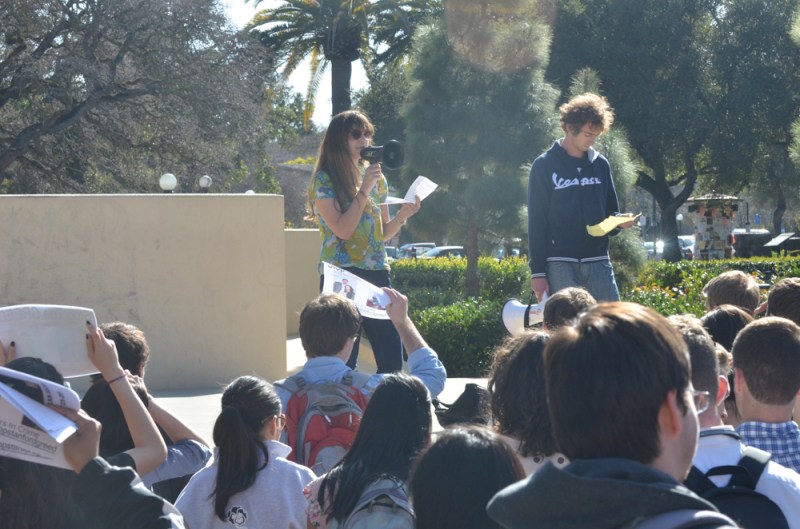This article is the first in a two-part series looking at University committees and students’ role therein. Today’s article looks at committees’ role and structure, while tomorrow’s article looks at the committees’ limitations to date.
Late February, a day after students gathered in the middle of White Plaza to protest of the University’s decision to end student management at Suites Eating Clubs, Vice Provost of Student Affairs Greg Boardman sat down with The Daily. Boardman talked about the controversy and the article – written by Miles Untereinner ’12 M.A. ’13, a Daily staffer — credited with sparking the movement.

In the interview, Boardman called the moment a “tipping point,” noting that the article forced administrators to ask the question: how are student voices being heard, and should this change moving forward?
“We have student representations on literally every University committee — is that not effective?” Boardman asked. “Are there other ways of engaging students in a different way, so they will have a say or input in some of the University decisions, which perhaps aren’t being utilized today?”
“I think this opens up an opportunity to really think,” he added. “How do we better ascertain what the student concerns are before decisions are made?”
According to a Faculty Senate report, the University’s system of committees provides “the best place for effective student participation in the governance of the University.” While students can serve on more than 40 committees in total, dealing with issues as varied as investment responsibility and laboratory animal care, their influence is often inconsistent and incomplete.
Hearing the student voice
All of the students interviewed for this article affirmed that serving on University committees has given them, to varying degrees, power to influence the direction of Stanford’s academic and administrative policies.
Jonathan York ’13, who this year will serve as a chair of the Nominations Commission (NomCom), argued that these committees can serve as an effective forum for communication between students and administrators, as well as playing an important role in the actual policy-setting process.
“This is probably the most direct and effective way to affect the Stanford community and to affect Stanford life,” he said. “It’s more effective than any protest, than any petition, than any ASSU bill — this is the way to affect change at Stanford.”
York has served on three different committees during his time at Stanford. He became a member of the Judicial Board Panel pool his freshman year and since then has also served as the chair of the Board on Judicial Affairs and as an undergraduate representative on the Board of Trustees’ Committee on Land and Buildings.
In the latter position, York said that he has often seen his feedback — on what students might like to see — incorporated into construction projects, such as the recent $13.15 million plan to renovate Florence Moore Hall. Even so, the renovation has upset some students by the proposed removal of catwalks from the residential buildings, on health and safety grounds.
York also mentioned the renovation of the Crown Quadrangle and Library, the third and final stage of the Stanford Law School overhaul, which will cost $22 million and tentatively be finished by the spring of 2014.
“One of the concerns that the graduate student on the committee and I voiced together was how is this construction is going to affect students because it’s close to a lot of study spaces, and we were able to say that,” York said. “We were able to ask the administrators in charge of that project to be mindful of the times of certain parts of the construction and how they could mitigate the impact on students.”
“You know, these are not big bureaucratic committees,” he added. “From my experience, these are really practical and functional organizations, and to have student voices on them makes them that much better.”
Brianna Pang ’13, who is a member of both the Advisory Panel for Investment Responsibility and Licensing (APIRL) and the Special Committee on Globalization this year, echoed many of York’s sentiments.
However, while Pang also believes the committee system is a fundamentally sound institution, she said that students are often not prepared to make the greatest impact possible when they are first appointed to these positions. As a result, committee members are not always able to advocate effectively for student interests, especially when they stand in opposition with the viewpoints of administrators.
“I feel that Stanford students have a lot more say, and their voices mean a lot more to administrators than at other schools, so I do commend Stanford administrators for creating these avenues for student voice,” Pang said. “But throughout my time on these committees, I’d have to say I think it’s hard to make a change or have a really strong voice in my first year because there is a learning curve for every committee.”
“I think that students have to learn A) what the campus vibe is on an issue and B) how to project that to administrators well and in an effective way,” she added.
There are several aspects of the system that may prevent the students from meeting these two objectives and representing their peers effectively, according to current committee members interviewed. These include the application process, which in previous years has struggled to produce nominations in time for training before the end of the school year, as well as a lack of communication between representatives and the student body after appointments are made.
There is also the concern that several areas of campus life — especially Residential Education — do not have formal standing committees, which could result in students being disconnected from some of the policy decisions that go on to affect them directly.
Structure of the committee system
In September 1969, the Faculty Senate adopted the “Report on the Committee Structure of the University.” This document continues, for the most part, to guide the responsibilities and operations of the committees at Stanford today.
According to the report, university committees are to “operate as policy-making and review bodies,” while leaving the “administration of these policies generally in the hands of the appropriate administrative officers.” The standing committees of the Academic Council, for instance, are charged with formulating policies on all matters related to teaching and research at the University. It is not until the Faculty Senate approves these policies, however, that they actually go into effect.
Currently, there are more than 40 different university committees, dealing with issues as varied as investment responsibility, undergraduate housing, laboratory animal care and KZSU. In addition to the Academic Council committees, which report to the Faculty Senate, the other committees most commonly fall under the purview of the University President, the Board of Trustees or the Vice Provost of Student Affairs.
These committees typically include nine voting members, with two or three of these spots being reserved for students. The report states, however, that “the more directly concerned committees are with student affairs, the larger might appropriately be the number of students involved.”
The Alcohol Advisory Board Committee, for instance, is focused on policies regarding student alcohol use. Because of its student-specific mission, this committee currently includes positions for five undergraduate and two graduate students, well above the norm for student representation. The Undergraduate Housing Advisory Committee similarly includes 10 student representatives.
The report further notes the importance of having students serve on these committees.
“We believe that the best place for effective student participation in the governance of the University is through active, voting membership on important committees, where the basic work will necessarily be done in most cases,” the report reads. “Working student members on all Academic Council and University standing committees, except those where students would clearly be inappropriate, provide the most promising mechanism for responsible and effective student participation.”
Students serve as “uninstructed members” of committees, according to the “Procedures for University Committees, Presidential Commissions,” which was drafted by Gerhard Casper during his time as University President.
This means that they are “free to use their judgment on issues” and are not required to serve as delegates for their peers.
While final appointments of these committee members rests with the body or individual they would report to, students have the ability to nominate peers to represent them though the ASSU. These nominations are then rarely, if ever, rejected. In his 13 years serving as University president, John Hennessy has never turned down the name of a student nominated to serve on one of his presidential committees, according to Jeff Wachtel, special assistant to the president.
The Board of Trustees does, however, request to receive more student nominations than there are positions on their committees, giving trustees the opportunity to interview potential candidates and make a final selection for themselves.
“They have their own process, and they don’t want to be told that you have to appoint so-and-so,” Wachtel said. “That’s been their practice and unwritten policy to have a more competitive process.”
Members of NomCom are responsible for interviewing candidates and putting forth this initial list of student nominees for the ASSU. The Undergraduate Senate and Graduate Student Council confirmed the seven students who will serve on NomCom at their meetings in late February. Of these members, York and John Dodini ’13 have been selected to serve as the commission’s two co-chairs.
The new NomCom members took office at the beginning of spring quarter, completing their one-year term at the end of winter quarter next year, and will receive stipends for their work on the commission according to ASSU budgets.
During the 2012-13 academic year, the NomCom chair received $1,627 and the deputy chair $1,405, the other five NomCom members splitting $4,436 worth of stipends. NomCom also received nearly $1,000 for recruiting expenses, $500 for food for students at committee meetings and $5,175.85 in discretionary spending.
NomCom put forth its first email soliciting applications for committee positions in mid-March, with an initial deadline of April 2. That date was extended this week to Friday, April 5 to give students more time to apply, according to an email sent out to the student body by ASSU President Robbie Zimbroff ’12 M.A. ’13, who serves as an ex-officio member of the commission.
